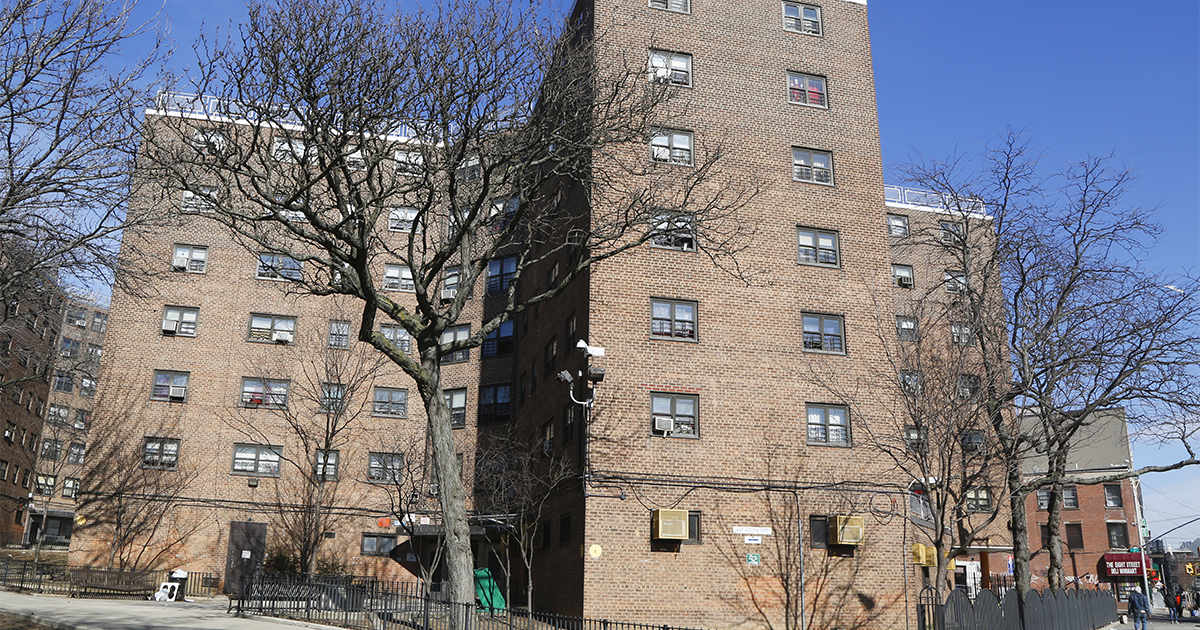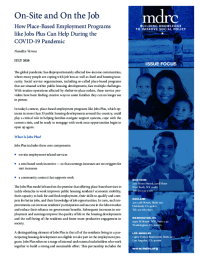On-Site and On the Job
How Place-Based Employment Programs like Jobs Plus Can Help During the COVID-19 Pandemic

The global pandemic has disproportionately affected low-income communities, where many people are coping with job loss as well as food and housing insecurity. Social service organizations, including so-called place-based programs that are situated within public housing developments, face multiple challenges. With routine operations affected by shelter-in-place orders, these service providers have been finding creative ways to assist families they can no longer see in person.
In today’s context, place-based employment programs like Jobs Plus, which operates in more than 35 public housing developments around the country, could play a critical role in helping families navigate support systems, cope with the current crisis, and be ready to reengage with work once opportunities begin to open up again.
What Is Jobs Plus?
Jobs Plus includes three core components:
- on-site employment-related services
- a rent-based work incentive — so that earnings increases are not triggers for rent increases
- a community context that supports work
The Jobs Plus model is based on the premise that offering place-based services to tackle obstacles to work improves public housing residents’ economic mobility, their capacity to look for and find employment, their skills to qualify and compete for better jobs, and their knowledge of job opportunities. In turn, such improvements can increase residents’ participation and success in the labor market and reduce their reliance on government benefits. Subsequent increases in employment and earnings improve the quality of life in the housing developments and the well-being of the residents and foster more productive engagement in society.
A distinguishing element of Jobs Plus is that all of the residents living in a participating housing development are eligible to take part in the employment program. Jobs Plus relies on a range of internal and external stakeholders who work together to build a strong and sustainable effort. This partnership includes the housing agency staff, the local workforce development agency training providers, the business community, and key social service agencies.
How has Jobs Plus been proven to increase earnings?
Jobs Plus began operating in the late 1990s and was replicated by multiple housing agencies across the country. In 2015 it was expanded further by the U.S. Department of Housing and Urban Development (HUD). Evidence of the program’s effects, based on MDRC’s original Jobs Plus evaluation, showed that in public housing communities where all components of the model were in place and implemented properly, residents earned 16 percent more per year than residents in comparison developments, an effect that endured over the seven years of follow-up analysis. HUD’s expansion of Jobs Plus is being evaluated by MDRC as part of a new study that will also provide important evidence about the sustained effects of the original program and whether the effects continue when the program is replicated in various settings.
How can housing agencies that operate Jobs Plus and other place-based programs help families? Here are some ideas to consider:
- Remind residents how the program is continuing to operate in the COVID-19 context. As service providers have pivoted to remote operations, residents may need to be reminded about how to connect with the program and take advantage of its services.
- Leverage existing connections with residents to assess their needs. Because programs like Jobs Plus are situated within housing developments, staff members can build on existing relationships with the families they have served to assess their circumstances, the challenges they are facing, and the kinds of support they could use. Some families may need help meeting basic food or other necessities, while others may need employment assistance or help keeping their children focused on school activities.
- Build connections with new or disengaged residents. It is not unusual for some members of the community not to take advantage of a program’s services. There can be many reasons for this, but the COVID-19 context provides a new opportunity for staff members to connect with such residents. They may be more receptive now to the employment and other services offered.
- Prepare families for returning to work. In general, public housing residents experience high levels of unemployment or underemployment. Because of the pandemic, many residents may have lost their jobs or may have concerns about their ability to return to work. What types of jobs will there be for them? What health risks might they face when they return to work? Will they be able to restore their earnings when employment prospects improve? What types of skills will they need to compete? In Jobs Plus, case managers and employment specialists can serve as an important bridge — helping residents assess their employment goals, understand the labor market, and identify and build the skills they need to compete in the workplace.
- Market the message: Work pays. Residents living in housing developments with a Jobs Plus program are eligible for the program’s work-based financial incentive. This allows families to increase their earnings without having to worry about a rent increase for the duration of the program grant. Residents returning to work as COVID-19 lockdowns begin to lift may also be eligible for this incentive. Program staff can promote this message using email and social media until face-to-face communications are restored. Other place-based programs can encourage residents to take advantage of financial work incentives they might qualify for, such as the Earned Income Tax Credit.
- Leverage — and strengthen — interagency collaboration. No single agency can serve all of the needs of the families in a community. The collaborative aspect of the original Jobs Plus demonstration, which involved mandatory partners, was an effort to build sustainable social services and employment supports. Establishing strong local partnerships also allows a program to offer a broader array of services and resources.
Jobs Plus is designed to respond to the many employment challenges that public housing residents face. Now, more than ever before, its service components provide a powerful framework for thinking about on-site interventions that support low-income families and their efforts to move to self-sufficiency.






